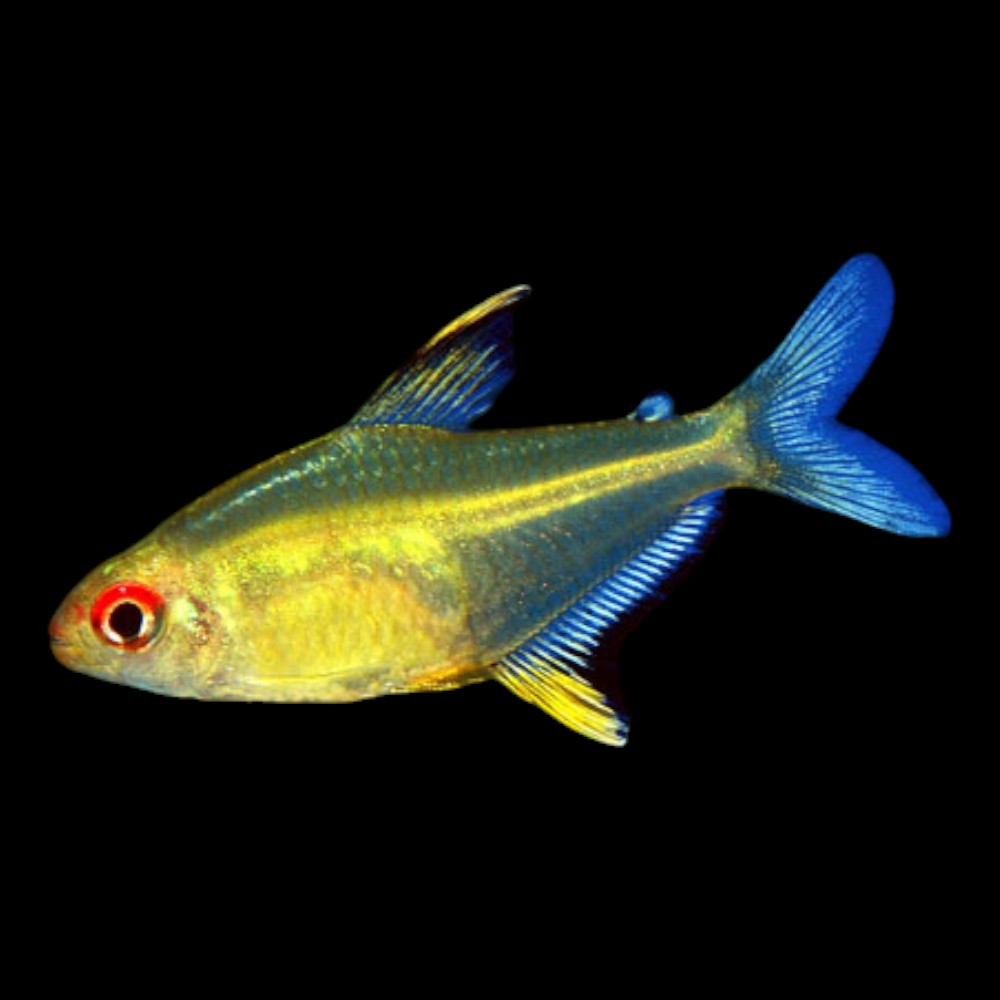Lemon Tetra

Lemon Tetras: Complete Care Guide for This Underappreciated Gem
The Lemon Tetra (Hyphessobrycon pulchripinnis) is a peaceful, lively, and visually striking freshwater fish that has earned a place in many well-planted community aquariums. Despite their subtle beauty compared to more neon-hued relatives, Lemon Tetras captivate aquarists with their delicate yellow colouring, bold black markings, and engaging schooling behaviour.
Native to the Tapajós River basin in Brazil, this species thrives in slow-moving, vegetation-rich waters. Their natural habitat can be easily replicated in the home aquarium, making them an ideal choice for aquarists of all experience levels, provided their specific care requirements are met.
Quick Facts
- Scientific Name: Hyphessobrycon pulchripinnis
- Common Name: Lemon Tetra
- Origin: South America (Brazil – Tapajós River)
- Size: Up to 5 cm (2 inches)
- Lifespan: 5–8 years (with proper care)
- Temperament: Peaceful, shoaling
- Tank Level: Midwater
Appearance
Lemon Tetras display a semi-transparent body with a gentle yellow hue that becomes more vibrant in healthy, well-fed fish. The distinctive black edge on their anal and dorsal fins, and their bright red eyes, make them especially attractive in planted aquariums under subdued lighting.
Juveniles and stressed individuals may appear pale, but colouration deepens with age, good water quality, and proper diet.

Behaviour and Compatibility
Lemon Tetras are highly social and must be kept in groups of at least six, though larger schools of 10 or more are ideal to bring out their best natural behaviour.
- Peaceful: Excellent community fish
- Active swimmers: Constantly moving through the mid-water region
- Compatible tank mates: Other peaceful tetras, rasboras, corydoras, dwarf gouramis, and small catfish
Ideal Water Parameters
Maintaining stable, clean water conditions is essential to their health and colouration. Here’s a detailed table of their preferred water parameters:
| Parameter | Ideal Range | Notes |
|---|---|---|
| Temperature | 22–28°C (72–82°F) | Ideal at ~25°C for long-term health |
| pH | 5.5–7.5 | Prefer slightly acidic to neutral |
| Hardness (dGH) | 3–15 dGH | Moderately soft to moderately hard |
| Ammonia | 0 ppm | Always toxic – must remain at zero |
| Nitrite | 0 ppm | Also toxic – monitor with regular testing |
| Nitrate | < 20 ppm | Control via water changes and plants |
| Lighting | Low to moderate | Encourages better colour and reduces stress |
| Tank Size | Minimum 60 litres (15 gallons) | For a small group; larger tank preferred |
Aquarium Setup
To create a natural, stress-free environment for Lemon Tetras, consider the following:
- Substrate: Dark sand or fine gravel to mimic riverbeds
- Plants: Dense planting with open swimming space; floating plants help diffuse light
- Decor: Driftwood and leaf litter enhance the biotope and support natural behaviour
- Filtration: Gentle flow preferred – sponge filters or canisters with spray bars
- Maintenance: Weekly water changes of 25–30% are recommended
Feeding
Lemon Tetras are omnivores with a preference for protein-rich micro foods. Provide a varied diet to enhance colour and health:
- Staple: High-quality flakes or micro pellets
- Supplement: Live/frozen daphnia, brine shrimp, bloodworms, and mosquito larvae
- Frequency: Feed small amounts 1–2 times daily; avoid overfeeding
Breeding Lemon Tetras
Lemon Tetras can be bred in captivity with the right conditions:
- Use a separate breeding tank with soft, acidic water (pH 5.5–6.5)
- Maintain dim lighting to encourage spawning
- Condition pairs with live foods
- Spawning typically occurs in the early morning
- Eggs are scattered and fall to the substrate; use fine-leafed plants or spawning mops
- Remove adults post-spawning to prevent egg predation
- Fry hatch in 24–36 hours and need infusoria or liquid fry food initially
Common Health Issues
Lemon Tetras are fairly hardy when kept in optimal conditions, but may suffer from:
- Ich (white spot disease): Caused by stress or poor water quality
- Fin rot: From bacterial infections, often due to dirty water
- Colour fading: Often stress-related or diet-related
Preventive care: Quarantine new fish, maintain pristine water, and feed a balanced diet.
Final Thoughts
Lemon Tetras are a beautiful and underrated species perfect for peaceful community aquariums. Their schooling behaviour, easy temperament, and subtle elegance make them an excellent addition for aquarists looking for something more refined than flashy neon varieties.
With proper care, Lemon Tetras will reward you with vibrant colour, lively activity, and years of enjoyment in a well-maintained aquarium.
Keywords for SEO:
lemon tetra care, Hyphessobrycon pulchripinnis, peaceful community fish, tropical aquarium fish, freshwater schooling fish, lemon tetra water parameters, tetra tank mates


